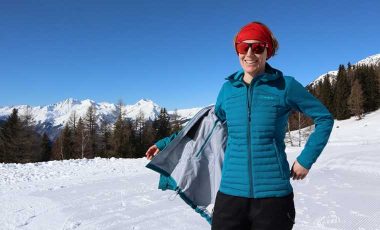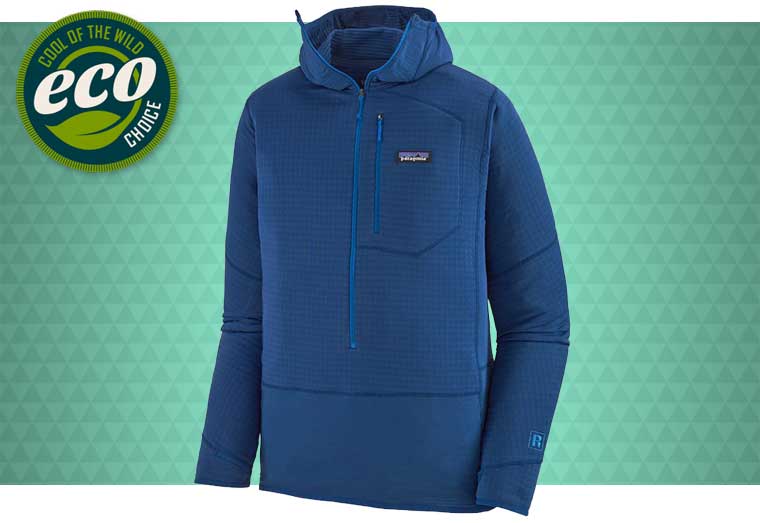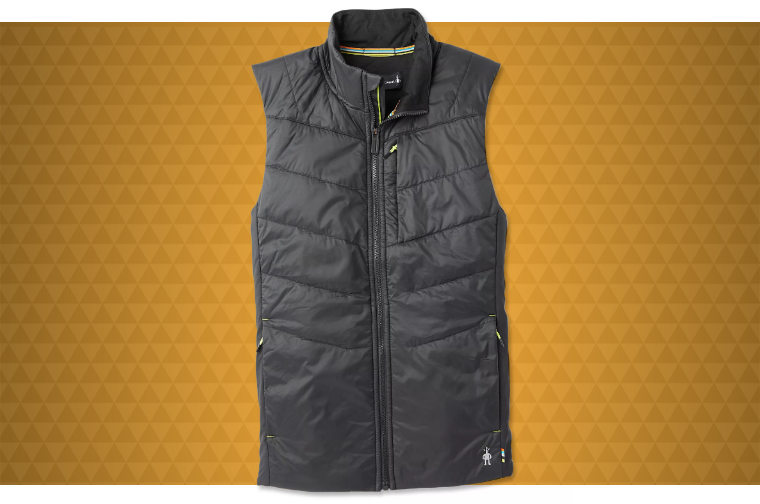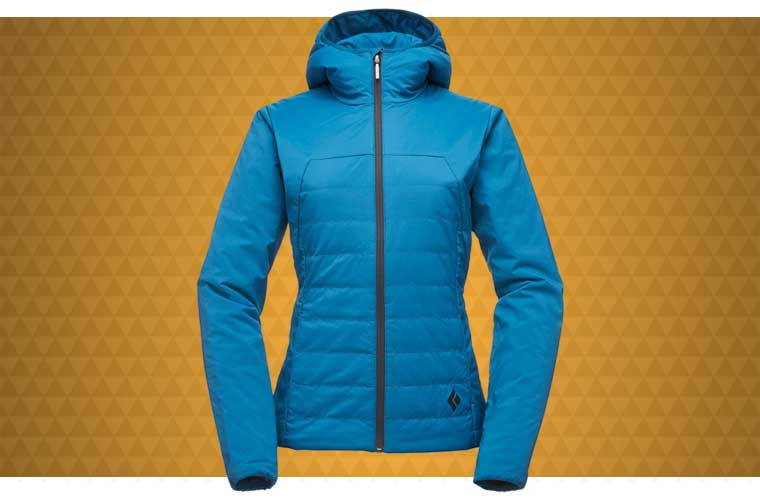Not getting your layering system right can ruin a day on the slopes. Too hot and you’ll sweat buckets, causing chafing and then a rapid lowering of your body temperature when you stop moving. Too cold, and you’ll run the risk of becoming slowly hypothermic. Both situations are less than ideal and potentially life-threatening. So choosing the best mid layers for skiing and snowboarding is actually a lot more important than you may realise!
- Fleece mid layers for skiing and snowboarding
- Insulated mid layers for skiing and snowboarding
- What is a mid layer?
- The properties of mid layers for skiing a snowboarding
- What are the different types of mid layers for skiing?
The best mid layers for skiing and snowboarding in 2024
Disclaimer: We use affiliate links and may receive a small commission on purchases.
| Product | Type | Insulation | Cost |
|---|---|---|---|
| Rab Capacitor Hoody | Fleece | 100% recycled polyester | $$ |
| Sprayway Clee Hoody | Fleece | 100% recycled polyester | $ |
| Isobaa Merino 320 Long Sleeve Half Zip | Fleece | 100% merino wool | $$$ |
| Patagonia Better Sweater Fleece Jacket | Fleece | 100% Recycled polyester | $$$ |
| Columbia Steens Mountain Fleece 2.0 | Fleece | Polyester MTR filament | $ |
| Patagonia R1 Fleece Pullover Hoodie | Fleece | Polartec Power Grid | $$$$ |
| Smartwool Smartloft Vest | Insulated | Merino wool | $$$$ |
| Ibex Wool Aire Hoody | Insulated | Merino wool | $$$$$ |
| Berghaus Nula Jacket | Hybrid fleece with insulation | Hydroloft Polyball and fleece | $$ |
| Rab Alpha Flux jacket | Synthetic insulated | Polartec Alpha | $$$ |
| Patagonia Nano-Air Light Hybrid Jacket | Synthetic insulated | 40g Full Range | $$$$ |
| Black Diamond First Light Hoody | Synthetic insulated | PrimaLoft Silver Insulation Active | $$$$$ |
Fleece mid layers for skiing and snowboarding
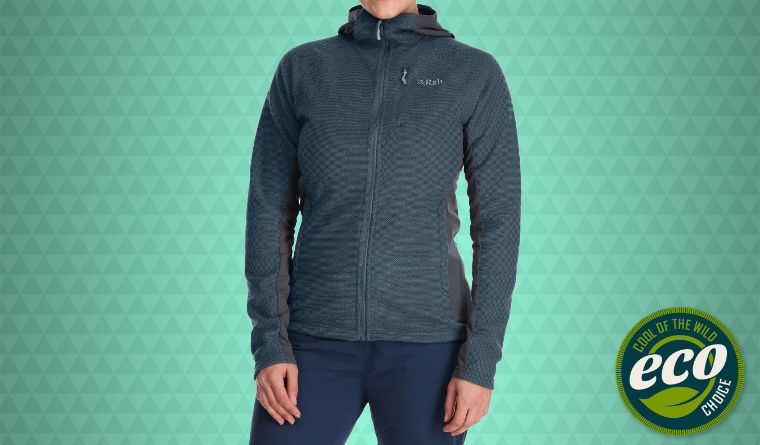

Rab Capacitor Hoody
New to Rab’s hike range in 2023, the Rab Capacitor Hoody is a super stylish, high performing mid layer that is as suitable for snowsports as it is for for days on the trail. Weighing only 354g/12.5oz, the Capacitor is one of the lighter weight mid layers that we’ve tried and it packs down decently small if you need an extra layer in your pack when ski touring, which is exactly the sort of mountain adventures that it is best suited to.
The Capacitor lacks the insulation of the likes of the Ibex Wool Aire, Patagonia Nano-Air and Black Diamond First Light. However, the lightweight thermic stretch side panels are excellent at wicking moisture away, staying breathable and drying quickly. Together with the warmer (200g/m²) fleece fabric of the main body of the hoody, this mid layer makes for the ideal option when charging hard on the mountain, ski touring and fast hiking. Alternatively, you’ll find it a very suitable layer for spring skiing worn underneath a hardshell.
I’m a big fan of the well-fitting hood which does a good job of keeping the draft out. And the elasticated and adjustable hem (which is longer at the back) is a nice touch that is often overlooked in this style of mid layer.
Finally, the Capacitor is very generous with its storage options, offering two internal stuff-it pockets, two hand pockets with discreet zippers and a zippered chest pocket.
Pros
- Lightweight and breathable
- Excellent freedom of movement
- Super soft and comfortable
- Dries very quickly with good moisture wicking
- Discreet zippered hand pockets
- Internal stuff pockets
- Chest pocket
- Stylish
Cons
- Not as warm as other options
- No thumb loops
Find the latest price at:
Rab | REI | Amazon
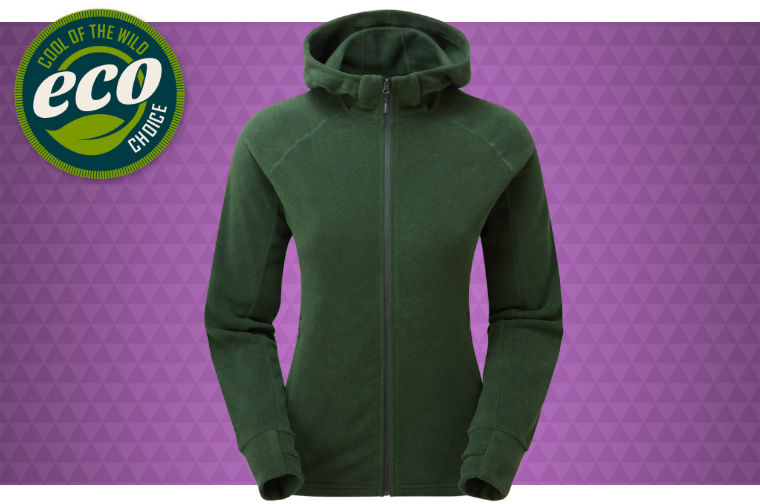

Sprayway Clee Hoody
If you’re after a low weight, high comfort, no frills mid layer then you really can’t go wrong with the Clee Hoody from Sprayway. It’s made from exceptionally soft recycled Polartec Micro 100 which feels delightful against the skin. It’s so soft that you’ll find yourself wearing it for more than just high-octane days on the slopes!
The form-fitting, but not tight, shape of the hoody has extra length at the rear hem which also features light elastication to keep it from riding up. I also very much enjoy the slot-style thumb loops which don’t leave a gaping hole in your sleeve when your thumbs aren’t in the loops.
I love a hood, and although this hood is super soft and spacious, it’s not as snug as I’d prefer and the high neck is also a little on the gaping side. I definitely need a high neck base layer underneath.
Overall, the Clee is simple, relatively low cost, has a lower environmental impact than standard fleeces and it’s also very effective at keeping you warm, with the right combination of other layers. Yes, there are warmer mid layers that we’ve tried that provide superior insulation, but then you’ll have to pay twice the price for them!
Pros
- Lightweight
- Excellent freedom of movement
- Super soft and comfortable
- Dries very quickly
- Discreet zippered hand pockets
- Internal stuff pockets
- Well-designed thumb loops
- Good value
Cons
- Not as warm as other options
- Hood and high neck are a little baggy
Find the latest price at:
Sprayway
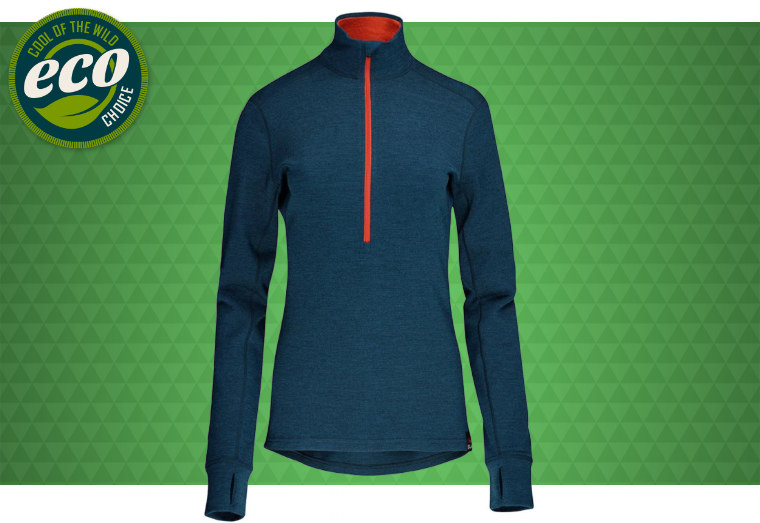

Isobaa Merino 320 Long Sleeve Half Zip
Though not made of microfleece, the 320 Long Sleeve by Isobaa performs in a similar way in terms of design and insulation. It’s the only 100% merino mid layer on our list. As such, it gains some serious brownie points in terms of micro-plastic pollution as well as offering some highly desirable features for the wearer. As with all merino clothing, this half zip mid layer is antimicrobial – takes days of wear before it gets stinky!, it’s thermoregulating – keeps you at a comfortable temperature in hot and cold conditions, and it’s also moisture wicking – great to prevent sweat build up and cooling.
On top of all that, this stylish and fitted mid layer has extra length at the back (a big plus for me to keep out the drafts), thumb loops and seamless pits for unrestricted movement.
The neck zip isn’t as deep as other options on our list, but a great addition all the same for venting or hunkering in, as needed.
It’s one of the more lightweight mid layers we’ve tried making it ideal for warmer days on the mountain or for layering up when the conditions are changeable.
Pros
- Super soft and comfortable
- Long back hem
- Thumb loops
- Moisture wicking
- Odour-resistant
- Temperature regulating
Cons
- Not as warm as other options
- Neck zip could be longer
Find the latest price at:
Isobaa
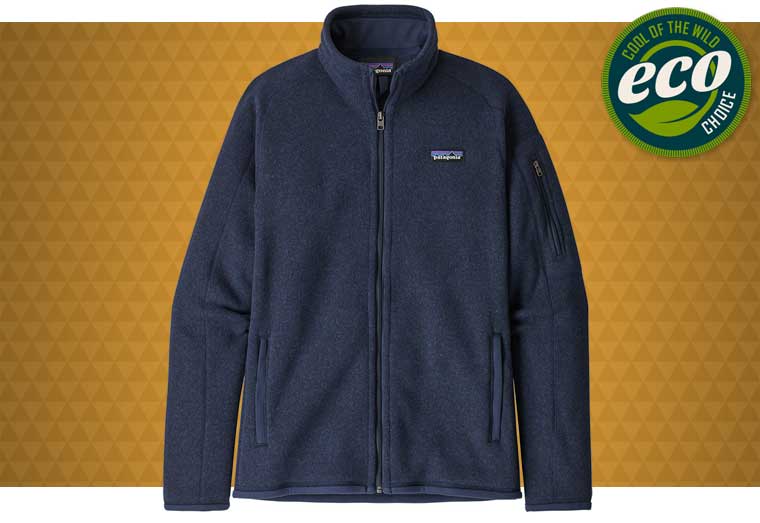

Patagonia Better Sweater Fleece Jacket
Made from 100% recycled polyester, the Patagonia Better Sweater Fleece Jacket is a superb option for eco-conscious skiers who favour versatility over several scenario-specific items. Though not as technical as some options on our list, it’s the ideal mid layer for casual skiers and snowboarders to wear on and off the slopes. Its classic style and cosy mid-weight warmth also makes it a winter essential for winter hikers and pub-goers alike. The high collar does an excellent job at keeping the draft out and the extra soft brushed tricot trims prevent abrasion in this sensitive area. Continuing on the cosiness theme, chilly-fingered folk will love the luxury of the large zippered hand pockets. These are best enjoyed without gloves on, which is convenient as there are large internal drop-in pockets to store said gloves!
Pros
- Zippered arm pocket for ski pass
- Versatile for everyday wear as well as on the slopes
- Warm with luxurious details
- Internal drop-in pockets
- High collar
Cons
- Zipper pulls are tough to use with gloves on
- The outer fabric is susceptible to pilling over time
- A little on the short side
Find the latest price on:
Snow and Rock | Patagonia | REI
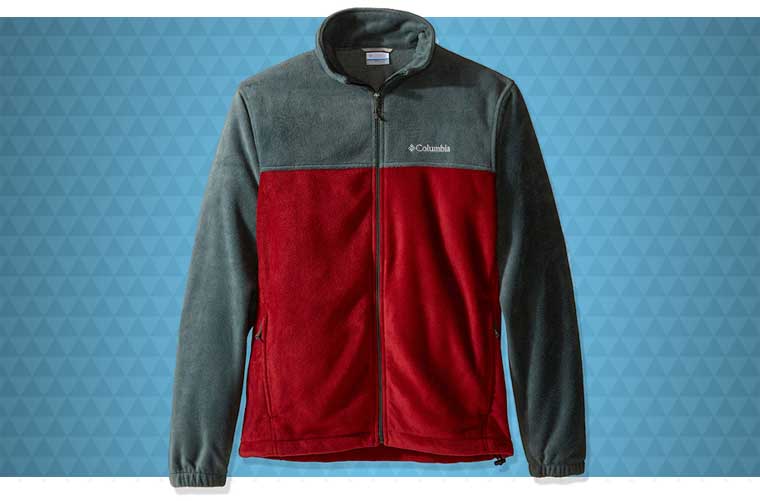
Columbia Steens Mountain Fleece 2.0
The Columbia Steens Mountain Fleece 2.0 is a good-old-fashioned frill-free fleece. Made from 100% polyester MTR filament fleece, this full zip jacket is more bulky than the Rab, Norrona and Mountain Hardwear options in this category. It is loose-fitting and there are no thinner panels to streamline the design, making it heavier, too.The few features include zippered hand pockets, a drawcord at the hem and elasticated cuffs. And although it is a decently warm fleece that is ideal for cold days on the mountain worn under a hard shell jacket, it certainly won’t win any prizes for innovative design or technical features. However, it is by far the most affordable option on our list, providing soft, cosy, light to mid weight warmth that really is hard to resist!
Pros
- Excellent value
- Comfortable
- Good warmth for moderately cool conditions
Cons
- Heavy
- Not a slim fit
Find the latest price on:
REI | Amazon | Backcountry
Patagonia R1 Fleece Pullover Hoodie
Though hooded mid layers aren’t for everyone, the hood of the Patagonia R1 Fleece Pullover Hoodie is ideal for those super chilly days when wearing an extra layer underneath a ski and snowboard helmet is essential. It fits snuggly over your head and is complemented by a high neck to further increase the cosiness and draft exclusion provided by the hood design. Other highly appealing design features include long sleeves with well-fitting thumb loops, a zippered chest pocket and a long zip at the neck for deep venting.
After 20 years of tweaking, this most recent version of the R1 boasts two fabric thicknesses, like the Berghaus. The core and arms of this lightweight hoodie are made from 6.9oz Polartec Power Grid fleece, which is soft and moisture wicking on the inside. The hood, side panels and lower body are constructed with a lightweighter weight 3.8oz grid that is slightly more stretchy and breathable than the core areas. The result is added comfort when wearing a hardness or backpack, increased mobility and temperature regulation, and overall excellent comfort levels.
It’s versatile and hardwearing. And though a little on the pricey side, we think it’s well worth the investment.
Pros
- Helmet compatible hood
- Lightweight (312g / 11oz)
- Good temperature control
- Deep venting neck zip
- Nicely long at the hem
Cons
- A little on the pricey side!
Find the latest price at:
REI | Patagonia | Alpine Trek
The best insulated mid layers for skiing and snowboarding
Smartwool Smartloft Vest
Vest mid layers may not be for everyone, however, they are an excellent alternative to a traditional long sleeved mid layer for spring skiing when the temperature is a little higher. Vests are also highly appealing for those who like lots of movement around the arms with complete freedom from both overheating and restricted movement.
Like the Ibex Hoodie (below), the Smartwool Smartloft Vest is insulated mostly with wool (88%), 50% of which is recycled/reclaimed. The other 12% of the fill is polyester. Additionally, the side panel fabric combines wool and polyester. The result is an extremely lightweight and airy-feeling vest that offers excellent temperature regulation and odour control in the most challenging and varied conditions.
The high neck keeps out the cold whilst the hand, chest and internal stash pockets provide plenty of options for storing snacks, money, phone and spare goggle lenses.
Pros
- Lightweight
- Excellent freedom of movement
- Good odour control
- Good temperature regulation
- High neck
Cons
- No arms! Not for everyone
- No hood, but can be a plus for some
Find the latest price at:
REI | Smartwool | Amazon
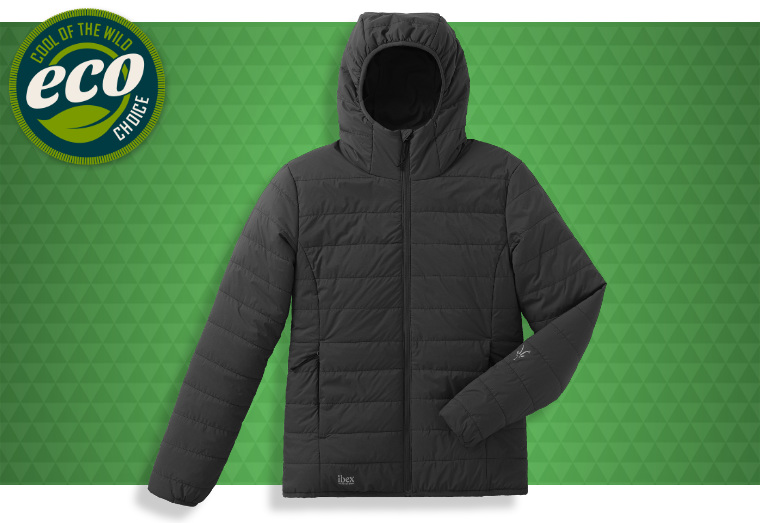

Ibex Wool Aire Hoody
The Ibex Wool Aire Hoody is a midweight insulated jacket that is as at home as an outer layer as it is as a mid layer underneath a hardshell. Uniquely, it owes its excellent insulating properties to 80 gram ethically sourced merino wool that fills the jacket. This gives it an impressive warmth to weight ratio for stuffing in your pack on those changeable mountain days or even for ski touring and splitboarding. But it also feels incredibly lightweight and comfortable when wearing it.
Despite its casual styling, it performs very well in more adverse conditions, boasting a water-resistant and windproof outer. The merino wool offers good breathability and moisture wicking with antimicrobial properties for odour control. Plus, elasticated cuffs fit over gloves snuggly and the whole jacket stuffs down into its own chest pocket.
Pros
- Excellent warmth-to-weight ratio
- Super lightweight
- Stylish
- Good as an outer layer too
Cons
- A little pricey
- Nood not adjustable
Find the latest price on:
Ibex
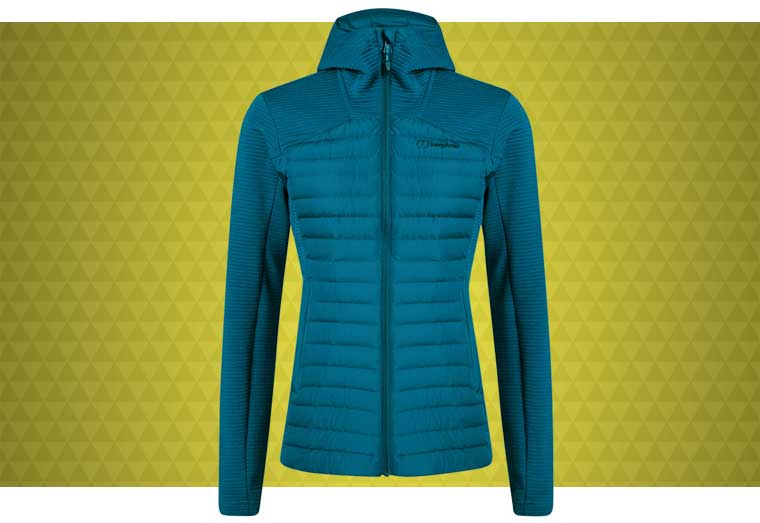

Berghaus Nula Hybrid Jacket
The new Berghaus Nula Hybrid Jacket provides exceptional warmth around the core of your body thanks to the Hydroloft Polyball insulation panels on the front and back of the jacket. The synthetic insulation feels incredibly lightweight on and also contains water resistant fibers to provide greater levels of weatherproofing. The rest of the jacket (hood, shoulders, arms and underarms) are constructed of a thin and lightweight knitted fleece that is soft to the skin and super breathable in all the right places. It also features a high collar and streamlined hood that works well underneath a helmet. The Nula really comes into its own, however, during high intensity activities in cold weather, like ski touring and splitboarding, when the body temperature fluctuates often. Plus, if it gets too warm to wear if packs down well into a pack and weights only 370g (13oz).
Pros
- Helmet compatible hood
- Good sized zipper pulls
- Fleece-lined, zippered hand pockets
- Long rear hem
- Lightweight for its warmth
Cons
- No thumb loops
- Fleece section is susceptible to pilling over time
Find the latest price at:
Berghaus | Cotswold Outdoor | Amazon
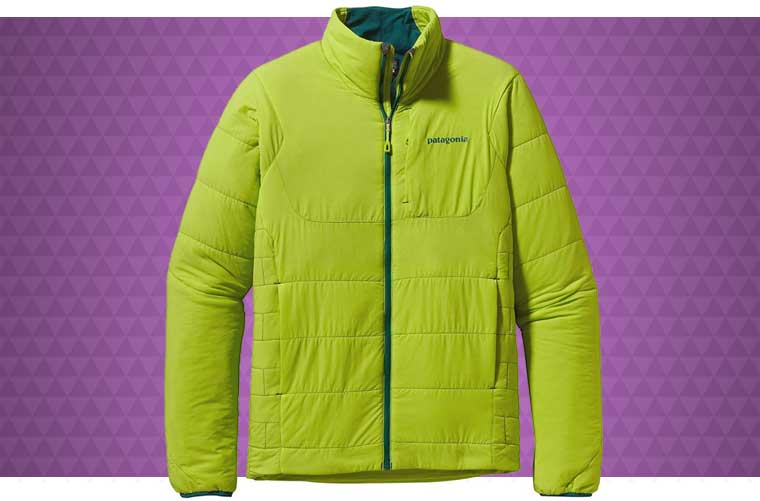
Patagonia Nano-Air Light Hybrid Jacket
The Nano-Air Light Hybrid Jacket is an inexplicably lightweight Patagonia mid layer that is made for skiers and snowboarders who value versatility, high performance, and the feeling of wearing nothing for warmth! The front panel and arms are filled with 40g Full Range synthetic insulation which is protected by a ripstop nylon shell that is also DWR coated. The back, sides and underarms, however, adopt a different fabric style altogether: Polygiene treated polyester waffle knit that is highly moisture wicking and controls odour. This hybrid design makes the Nano-Air an ideal mid layer underneath an outer shell on cold mountain days, as well as a standalone jacket for ski touring, spring skiing and year-round adventures in cool conditions.Pros
- Moisture wicking
- Very lightweight
- Good weather resistance
- Versatile
- Has thumb loops
Cons
- Not as warm as the fleece options
- No hood
Find the latest price at:
Patagonia | REI
Black Diamond First Light Hoody
For those that struggle with the idea of wearing down insulation in potentially wet conditions, the Black Diamond First Light Hoody is an excellent alternative. This mid weight mid layer features PrimaLoft Silver Insulation Active, which lets the jacket breathe during even the toughest days on the slopes. It boasts a stretch-woven nylon outer that is lightweight and durable, and NanoSphere durable water repellent (DWR) coating, making it ideal as a standalone layer for ski touring or charging hard in the backcountry. Other features include zippered hand pockets, an internal chest pocket that the jacket stows into, an insulated hood and elasticated cuffs.
Pros
- Very warm
- Good weather resistance
- Durable
- Versatile
- Breathable
Cons
- Not as moisture wicking as Polartec mid layers
Find the latest price on:
Amazon | REI | Backcountry

What is a mid layer?
A mid layer, believe it or not, is the layer that you wear over the top of a base layer, and underneath an outer layer. Simples! It is usually slim fitting, comfortable, moisture wicking and breathable. But first and foremost the best mid layers for skiing and snowboarding are designed to provide warmth and insulation.
While an outer layer will help keep out the rain, snow and wind, and a base layer will wick moisture away from your body, a mid layer provides warmth.
The properties of mid layers for skiing a snowboarding
Insulation and warmth
This is the most important property of mid layers for skiing and snowboarding. Insulation is provided by varying fabrics that cleverly trap air within their fibers. The tiny pockets of air trapped between the fibers create a cosy layer of insulation.
Fit
Most mid layers are usually slim fitting so as not to create too much bulk beneath an outer layer. That’s not to say that they are restricting in any way. Quite the opposite. They provide high levels of movement by using flexible or stretchy fabrics that move with the body.
Breathability and moisture wicking
Another important property of mid layers is the ability for moisture build up to be moved away from the body and clothing. Good base layers, that sit directly on the skin, will wick away the moisture from the body. This moisture then needs to be transferred out of the layering system altogether. Mid layers made with breathable fabrics enable this to happen. Synthetic fabrics are especially good at this, and the whole process speeds up the drying process, preventing fabrics from becoming saturated and uncomfortable.
Packability
Although not a deal breaker, a mid layer that is lightweight and packable is a definite plus. On days when you’re not sure how the conditions will turn out you don’t want to be lugging around a bulky and heavy mid layer in your pack, should you need to shed a layer. This is especially important when ski touring. Down mid layers are the most compressible and packable of all the options.
Weather resistance
On warmer, drier days in the mountains, it can be a big bonus if your mid layer can also provide enough protection to be worn as an outer layer. Many mid layers have outer shells that are made from durable fabrics and are treated with a DWR (durable water resistant) coating. This makes them wind and water resistant and adds more versatility to layering systems.
What are the different types of mid layers for skiing?
Fleece mid layer
Features: Moisture wicking, breathable, warm, quick drying, durable, inexpensive, holds onto odour, can be bulky.
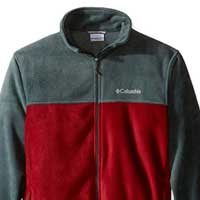 Probably the most common type of mid layer for skiing and snowboarding is a synthetic fleece. Usually made from polyester, fleece mid layers are a durable and relatively inexpensive option. They are available in different weights/thicknesses for a variety of conditions. There are also technical versions of synthetic fleece, like Polartec Alpha, that perform better than regular fleece fabrics.
Probably the most common type of mid layer for skiing and snowboarding is a synthetic fleece. Usually made from polyester, fleece mid layers are a durable and relatively inexpensive option. They are available in different weights/thicknesses for a variety of conditions. There are also technical versions of synthetic fleece, like Polartec Alpha, that perform better than regular fleece fabrics.
Down insulation
Features: Very warm, highly compressible, lightweight, durable if cared for well, expensive, lose insulation when wet.
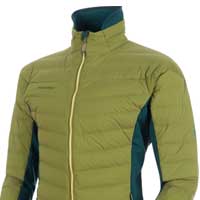 Down insulated mid layers are hands down the warmest type of mid layer on offer. They are also the most expensive and don’t provide warmth when wet. Ideal for those super chilly bluebird days. The level of warmth is measured by the weight of the down (how much down is in the jacket), and the fill power (how lofty/dense the down is). For more information on this, read our down vs synthetic article.
Down insulated mid layers are hands down the warmest type of mid layer on offer. They are also the most expensive and don’t provide warmth when wet. Ideal for those super chilly bluebird days. The level of warmth is measured by the weight of the down (how much down is in the jacket), and the fill power (how lofty/dense the down is). For more information on this, read our down vs synthetic article.
Synthetic insulation
Features: Warm, breathable, quick drying, stays warm when wet, highly durable, lightweight.
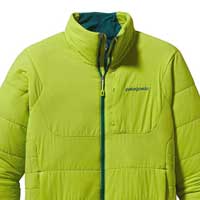 Mid layers with synthetic insulation offer more warmth than fleeces, but can never compete with the warmth offered by down jackets, relative to their weight. They also sit between the two when it comes to price. However, they do offer excellent insulation when wet, and impressive warmth, breathability and protection against the elements. Filled with fibers that mimic the properties of down, technical synthetic insulation like Primaloft also offer superb durability and are an excellent option in wet/moist conditions.
Mid layers with synthetic insulation offer more warmth than fleeces, but can never compete with the warmth offered by down jackets, relative to their weight. They also sit between the two when it comes to price. However, they do offer excellent insulation when wet, and impressive warmth, breathability and protection against the elements. Filled with fibers that mimic the properties of down, technical synthetic insulation like Primaloft also offer superb durability and are an excellent option in wet/moist conditions.
Whether you charge hard in the backcountry or enjoy cruising the groomed runs, there’s certainly something that is perfect for you on our list of the best mid layers for skiing and snowboarding.


